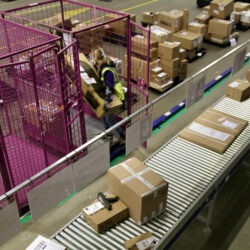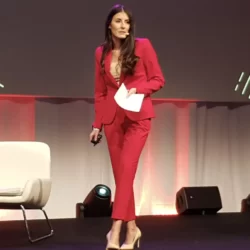FedEx continues to fine-tune its network

FedEx transports some 14.5 million parcels a day worldwide. And that number is a lot higher in December. In order to deliver all parcels and pallets on time, at home and abroad, the express carrier has a sophisticated network in which nothing is left to chance. Supply Chain Media visited the facility in the Dutch village of Elst, where continuous improvements contribute to faster and more efficient parcel handling.
By Marcel te Lindert
FedEx’s origins lie in the business parcel market. “We increasingly serve residential areas, but we still deliver the majority of our parcels to business parks,” says Marius Penninks, who is responsible for operational activities in the Benelux. According to him, the number of shipments starts to increase in September. “We ensure that shops and warehouses have sufficient stock to meet consumer demand in November and December. That’s why our peak lasts a bit longer than in the case of carriers that mainly deliver parcels to consumers.”
FedEx’s peak planning starts months in advance. The parcel carrier asks its customers for a forecast, but also analyses its own historical data. “This way, we try to make an accurate estimate of the required capacity,” states Ralph Albers, who is in charge of the operation in Elst. “Then it’s a matter of scaling up, using subcontractors when it comes to the transport process, and using temporary workers when it comes to the warehouse process. And our 130 permanent employees know that they can take fewer leave days during this period.”
Combined delivery and collection
To transport all shipments as quickly and efficiently as possible, FedEx has an extensive network in which processes are aligned as much as possible. This starts at the Elst site, one of FedEx’s 700 pick-up & delivery stations in Europe. From here, more than 100 vehicles leave every day to deliver shipments in the area edged by Venlo, Veenendaal, Apeldoorn and Enschede. Around two-thirds of the vehicles are delivery vans carrying parcels, while the remaining vehicles are trucks for transporting pallets.
As they drive through their area, FedEx drivers also stop at customers to pick up parcels and pallets. “These can be regular pick-ups from customers we visit every day. In addition – depending on the exact address – customers can book a shipment until as late as four or five in the afternoon. We notify a driver nearby, who picks up the shipment the same day. And customers near Elst can even book a shipment until 5.30 p.m.”
Higher load factor
Some customers have so many shipments that FedEx picks them up directly. These customers are increasingly choosing to offer the shipments as loose loads rather than stacking them on pallets. “We’re making a transition towards loose loading,” says Penninks. “We used to work with roll cages that we first filled with parcels and then loaded into the truck using a forklift. Now that we have opted for loose loading, we can make maximum use of the cargo space up to the roof. That leads to a higher load factor.”
Elst is home to a new sorting system that at the end of each day splits all incoming parcels into two flows: one for road transport, and one for air transport. Most of the parcels go to the Dutch town of Duiven, where one of the company’s 28 road hubs in Europe is located. “What sets us apart from other express carriers is that we fully own the international road transport network,” says Penninks. “We have our own stations, our own road hubs and a large proportion of our own trucks that provide linehauls between the stations and the road hub. That leads to a better customer experience when customers book a shipment or get a status update.”
Secure air cargo chain
To keep the network running smoothly, FedEx keeps to a strict timetable. Above the docks in Elst is a large screen showing each dock door with the trailer number, destination, departure time and time remaining. Albers: “The forklift drivers can see for themselves which trucks are due first. In addition, a coordinator walks around checking the process, getting the paperwork in order and closing the doors on time. Because if a truck doesn’t leave on time, it leads to delays at the next hub.”
Parcels and pallets destined for air cargo go to the aviation secured area, which is only accessible to operators with special security training in accordance with the requirements of the Netherlands’ military police. Each parcel passes through an X-ray machine, just like a suitcase would at the airport, to check the contents for components that could endanger the flight. All approved parcels and pallets then go in an air cargo container to Schiphol Airport, Liège, Paris or Cologne. Penninks: “Here in Elst, the aircraft containers enter a secure air cargo chain, so they no longer need to be unpacked and checked at the airport.”
Customs warehouse
Because many of the shipments come from countries outside the European Union – including parcels from Chinese e-commerce companies – the Elst site is an official customs warehouse. The shipments that Customs wants to check are kept in a fenced-off area. “That’s also where we store shipments for which we’re waiting for the recipient to pay import duties and VAT, for example,” Penninks says.
Penninks also states that the changes to the regulations two years ago for imports of small parcels have had a significant impact on the operation. The VAT exemption for parcels worth up to €22 was scrapped, meaning that all such packages now require a separate declaration. “That means that in addition to receiving a parcel, many recipients now also receive an invoice for the VAT they have to pay. Sometimes it’s a challenge to actually collect that money.”
Internal loading of vans
Around midnight, once all parcels and pallets have left the premises in Elst, FedEx has a few hours to prepare for the first trucks arriving with shipments for the next day. The express carrier has also adapted this process to ensure fast and efficient handling.
One example is the loading of the vans, which takes place entirely inside the building the next morning. To this end, the vans reverse up against the sorting system so that the parcels can be placed directly on the right shelf inside. “We also have stations where we first sort out all parcels into roll containers. But then we have to unload them from the roll containers and reload them into the vans, so the parcels are handled several times. The approach we use in Elst is considered best practice within FedEx.”








